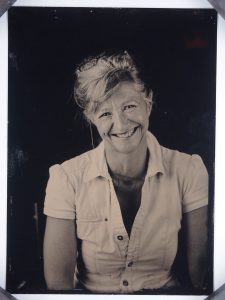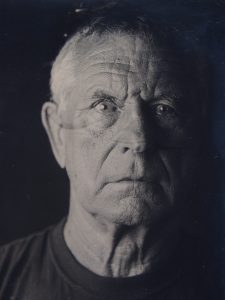
An ambrotype is an application of the wet plate collodion technique to make a thin negative image on a transparent material, usually glass, which when viewed against a dark background is seen as a positive image.
In the one day workshop, you will make a wet plate collodion ambrotype – the workshop cost is 60 euro and includes all materials which I have already prepared. You will do all the other processes, exposure, development and finishing.
The process requires coating a scrupulously clean glass plate with a thin layer of “salted” collodion which is made photo sensitive by immersion in a silver nitrate solution.
While the plate is still “wet” it is kept out of the light and carefully placed in a suitable camera. It is then exposed in the camera, removed, again away from light, and developed in a safe “darkroom”.
The development is “stopped” and the plate is then “fixed”.
The process from sensitisation to fixing needs to be completed before the coating on the plate begins to dry (hence the term “Wet Plate” photography, this process takes, typically, three to five minutes.
After fixing, the plate is dried carefully and then “varnished” to protect the very thin and fragile coating.
Ambrotypes are usually backed by a a dark material or paint – ambrotypes can be coated by a black varnish on the emulsion side – this has the advantage that the image is not reversed and is protected by the glass so separate varnishing is not necessary.
Black glass can be used which avoids a backing material.
A black (or other colour) metal plate can be coated and sensitised instead of glass, this is usually called a “Tintype” although most modern “tintypes” are made on black anodised aluminium..
I have suitable cameras and lenses for the process which you can use – I advise a practical working size of 13 x 18 cm – but you can make an ambrotype (or “tintype”) with just about any camera.
You will work with daylight or with artificial light and “strobe” lighting if the weather is not suitable for much daylight work (we do get 300 days of sunlight a year on average, but the “quality” and quantity of the UV in the daylight changes depending on the season.
Other collodion workshops will include :-
- Mixing salted collodion formula (half day 40 euro)
- Making varnish (half day 40 euro)
- Maintenance of the silver nitrate solution
- Making a silver bath tank.
- Making a (almost) 5 x 4 inch camera for wet plate
- Wet plate collodion negatives
- Dry plate negatives


